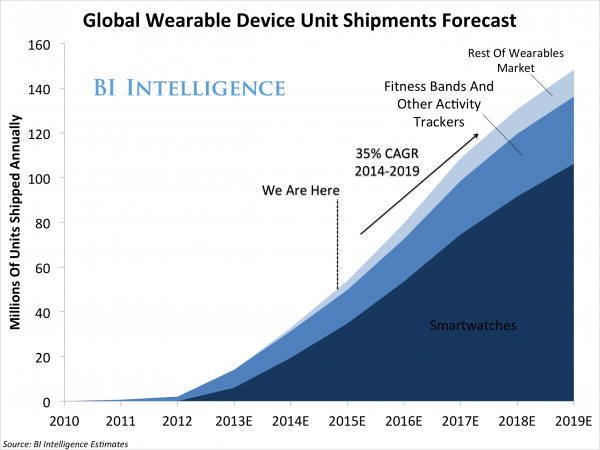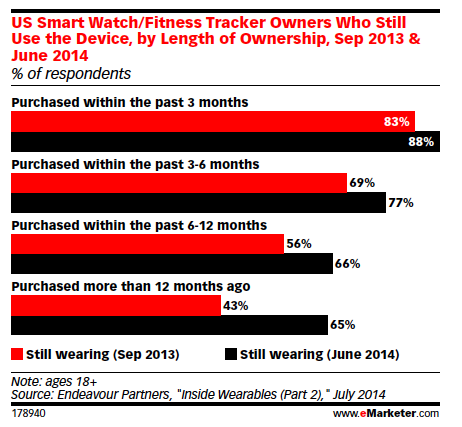2014 will be remembered for mobile passing over desktop, and now that mobile is entering the mature stage, what’s the next wave for web and digital tech? Wearables -a.k.a. wearable tech, of course!. Wearable tech has been one of my favorite trending topics in 2014. It is the biggest emerging new market and if you’d like to be ahead of the markets you cannot miss this.
Market research is coming up with amazing numbers for wearable tech’s future: IDC forecasts 119.8 million units shipped in 2018 with CAGR of 78% in the 2014-2018 period, while Deloittle estimates a 900% increase of units shipped between 2014 and 2020. Business Insider points to a fabulous 200% increase of shipped unites over 4 years, with the biggest slice going to smartwatches.
However, I have one major perplexity about this projection: the wearable tech market is too young and its potential applications so wide, and still pretty scattered, that smartwatches as the largest product category sounds very conservative, not to say unimaginative. My hunch is indeed shared by the respondents to a Business Insider’s poll (a very tech savvy audience), where 51% said that they do not see the point of owning a smartwatch, yet. And if the early adopters are not adopting, who is? My opinion is that as it happened in all for all new digital tech since the birth of the web, we should expect a disrupting application that will change this game-plan and push through wearables adoption, because people are definitely ready, but you can find limited uses for new products like fitness trackers. Indeed, the enthusiasm for them seems to be quick to wane, a research conducted by Endeavor Partners found that less than 50% of people uses their fitness tracker 12 months after purchasing it. That may be the reason why manufactures like Jawbone are fancying them up as fashion bracelets.
On the side:
13% of the Business Insider’s poll respondents said that they don’t like to wear a watch at all. I so hear you guys! Ditching the watch was the first thing I did after getting used to a cell phone. And I haven’t gone back ever since…
In order to get better clues of the future of the web and wearable tech, perhaps we need to take a peek at the bigger picture, that is the so called “Internet of Things“, which already has its own acronym IoT. If you haven’t come across the Internet of Thing yet, it is the network of every day objects connected through digital technology.
Cloud computing + a variety of connected devices = Internet of Things
The first example is of course home automation that just these days is reaching mainstream with the first TV ads by Nest. The field of applications is really wide and therefore IoT’s key figures are even more astonishing than wearable tech. Globally the IoT industry will be worth $3.04 trillions by 2020, for a total of 30 billion devices connected. (source: IDC). From smart cities whose infrastructure upgrades will be worth $40 trillions in the next 20 years (source Intel), to smart cars that could save $ 100 BN yearly by reducing accidents, to health monitoring is another important field of application.
Globally the IoT industry will be worth $3.04 trillions by 2020, for a total of 30 billion devices connected.
The health industry will also be an important part of IoT: digital diagnostics, such as ultra fast CAT Scans, digital monitoring & therapy with wearable devices are just the tip of the iceberg, as the big business -worth $300 billion only in the US according to McKinsey & Co, will be managing and making sense of all the data collected through the devices.
As Laurel Papworth, social media educator, explained, “Every part of our life will be quantifiable, and eternal, and we will answer to the community for our decisions. For example, skipping the gym will have your gym shoes auto tweet (equivalent) to the peer-to-peer health insurance network that will decide to degrade your premiums.” (source Pew Research).
As in all the best futuristic novels set in ideally efficient worlds, also IoT has a dangerous dark side that needs to be brought to light. Experts point at several main areas of concern for IoT: infrastructure unpreparedness, security of data, privacy and increased digital divide, these are all critical factors that too often are not properly accounted for in the enthusiastic accounts on the future of this industry.
Therefore if you adopt wearable tech in 2015, be aware you will be kind of entering in a Western frontier saloon, better not get too drunk on it because you never know when next gun fight is going to start and the sheriff has not been appointed yet.


